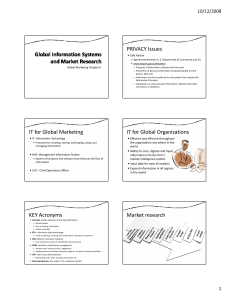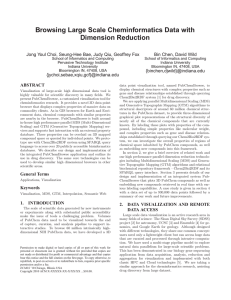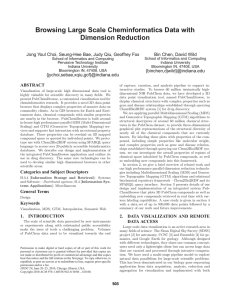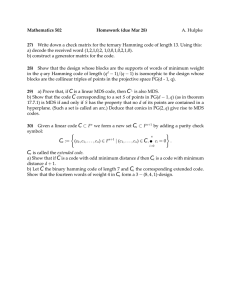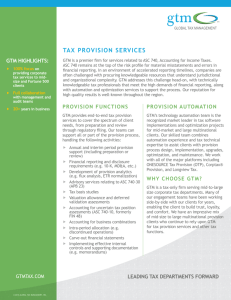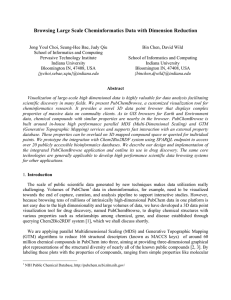Browsing Large Scale Cheminformatics Data with Dimension Reduction
advertisement
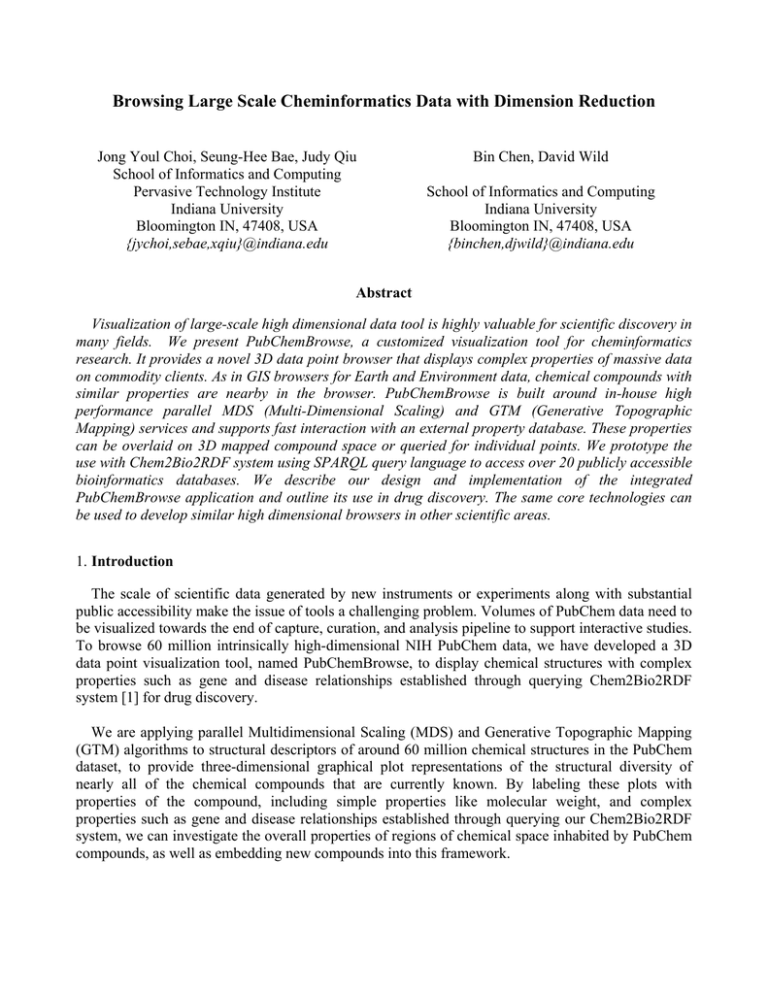
Browsing Large Scale Cheminformatics Data with Dimension Reduction
Jong Youl Choi, Seung-Hee Bae, Judy Qiu
School of Informatics and Computing
Pervasive Technology Institute
Indiana University
Bloomington IN, 47408, USA
{jychoi,sebae,xqiu}@indiana.edu
Bin Chen, David Wild
School of Informatics and Computing
Indiana University
Bloomington IN, 47408, USA
{binchen,djwild}@indiana.edu
Abstract
Visualization of large-scale high dimensional data tool is highly valuable for scientific discovery in
many fields. We present PubChemBrowse, a customized visualization tool for cheminformatics
research. It provides a novel 3D data point browser that displays complex properties of massive data
on commodity clients. As in GIS browsers for Earth and Environment data, chemical compounds with
similar properties are nearby in the browser. PubChemBrowse is built around in-house high
performance parallel MDS (Multi-Dimensional Scaling) and GTM (Generative Topographic
Mapping) services and supports fast interaction with an external property database. These properties
can be overlaid on 3D mapped compound space or queried for individual points. We prototype the
use with Chem2Bio2RDF system using SPARQL query language to access over 20 publicly accessible
bioinformatics databases. We describe our design and implementation of the integrated
PubChemBrowse application and outline its use in drug discovery. The same core technologies can
be used to develop similar high dimensional browsers in other scientific areas.
1. Introduction
The scale of scientific data generated by new instruments or experiments along with substantial
public accessibility make the issue of tools a challenging problem. Volumes of PubChem data need to
be visualized towards the end of capture, curation, and analysis pipeline to support interactive studies.
To browse 60 million intrinsically high-dimensional NIH PubChem data, we have developed a 3D
data point visualization tool, named PubChemBrowse, to display chemical structures with complex
properties such as gene and disease relationships established through querying Chem2Bio2RDF
system [1] for drug discovery.
We are applying parallel Multidimensional Scaling (MDS) and Generative Topographic Mapping
(GTM) algorithms to structural descriptors of around 60 million chemical structures in the PubChem
dataset, to provide three-dimensional graphical plot representations of the structural diversity of
nearly all of the chemical compounds that are currently known. By labeling these plots with
properties of the compound, including simple properties like molecular weight, and complex
properties such as gene and disease relationships established through querying our Chem2Bio2RDF
system, we can investigate the overall properties of regions of chemical space inhabited by PubChem
compounds, as well as embedding new compounds into this framework.
Figure 1. System architecture for PubChemBrowse
In section 2, we give a brief overview of related work and our high performance parallel dimension
reduction technologies including Multidimensional Scaling (MDS) and Generative Topographic
Mapping (GTM) algorithms and relational biochemical repository framework – Chem2Bio2RDF and
its SPARQL query interface. Section 3 presents details of our design and implementation of an
integrated system PubChemBrowse that plots 3D PubChem compounds as well as embedding new
compounds retrieved in real time with various labeling capabilities. A case study is given in section 4
with a data set of up to 930,000 data points followed by a summary of our work and future
improvements.
2. Data visualization and remote data access
Large scale data visualization is an active research area in many fields of science: The Sloan
Digital Sky Survey (SDSS) project [2] for astronomy, UCSC [3] and Ensemble [4] for genomics, and
Google Earth for geology. Although designed with different technologies, they share one common
concept: users need only a lightweight client but can access huge data that are curated and processed
through intensive computation. We have used a multi-stage pipeline model to explore natural data
parallelism for large-scale scientific problems. This has been demonstrated in our biological gene
sequencing application from data acquisition, analysis, reduction and aggregation for visualization
and implemented with both classic HPC and Cloud technologies [5]. We are taking a similar
approach for the cheminformatics research, assisting drug discovery from large dataset.
It is also worth mentioning that [6] has introduced data visualization for drug discovery and a
visualization tool. We present the same type of tool for drug discovery but we integrate our system
with more cutting-edge technologies: high-performance visualization algorithms based on HPC and
Cloud environments, large data access by using semantic web technologies, and a lightweight 3D
visualization client.
In the field of drug discovery, which aims at mining cause-and-effect relationships between genes
and diseases from large volume of data sources, one needs to access various kinds of databases – such
as PubChem for chemical compounds and structures, the Comparative Toxicogenomics Database
(CTD) for chemical gene information, the DrugBank database for drug target association to name a
few – and visualize them in 2D or 3D space to explore findings and verify results.
More specifically, such process typically involves three main tasks: i) visualizing multidimensional PubChem data in 3D space, ii) finding relationships from various public databases, such
as gene-compounds and/or disease-compounds, and assigning labels to chemical compounds, and iii)
displaying labels by using different colors or symbols in the previous 3D visualization and exploring
the results. The last two steps can be repeated until we have meaningful discovery by overlaying new
information to the previous results.
Authors have been researching on developing high performance visualization algorithms, such as
parallel MDS and GTM and their interpolation extensions [7, 8], to visualize large PubChem dataset
in 3D space by using our in-house 3D data point visualization tool and now we extend its
functionality to access external data sources in a dynamic way.
An issue in dealing with various types of databases in drug discovery is that databases are often too
big to store in local storage and hard to maintain consistency with the original dataset since their
frequent updates. Another issue can arise due to non-uniform data structures. Typically those
databases are not compatible to each other so that elaborated work needs to be done to use them
together. To overcome such problems, Chem2Bio2RDF system has been developed to aggregate
various public databases for chemical and biological information and provide an uniform interface
which enables users to access the multiple databases by using SPARQL as a standard query language
in semantic web technology. Our new tool, named PubChemBrowse, can interact with
Chem2Bio2RDF system by using SPARQL query to access various databases and large number of
datasets in an online and uniform way.
2.1. Data visualization algorithms
Among many dimension reduction algorithms, we focus on using Multidimensional Scaling (MDS)
[9, 10] and Generative Topographic Mapping (GTM) [11] due to their popularity and theoretical
strength. Although both GTM and SOM share the same object to find a map in low-dimensional userdefined space out of the data in high-dimensional space, GTM, however, finds a mapping based
probability density model, which SOM lacks of. On the other hand, MDS tries to construct a mapping
in target dimension with respect to the pairwise proximity information, mostly dissimilarity or
distance. More details are as follow.
MDS : Multidimensional scaling (MDS) is a general term of the techniques to configure low
dimensional mappings of the given high-dimensional data with respect to the pairwise proximity
information, while the pairwise Euclidean distance within the target dimension between two points is
approximated to the corresponding original proximity value. In other words, MDS is a non-linear
optimization problem with respect to the mapping in the target dimension and the original proximity
information. The STRESS [12] value is a well-known objective function of MDS, and Eq (1)
represents STRESS function:
(1)
Among many MDS solution, we use SMACOF algorithm which is based on Expectation
Maximization (EM)-like iterative majorization method. For details of the SMACOF algorithm, please
refer to [13].
GTM : GTM is an unsupervised learning algorithm for modeling the probability density of data
and finding a non-linear mapping of high-dimensional data in a low-dimension space. GTM is also
known as a principled alternative to Self-Organizing Map (SOM) which does not have any density
model, GTM defines an explicit probability density model based on Gaussian distribution [11] and
seeks the best set of parameters to maximize the log-likelihood of Gaussian mixtures (2), as an
objective function, by using Expectation-Maximization (EM) method.
(2)
MDS and GTM Interpolation : Both are an extension to the original MDS and GTM algorithm,
designed to process much larger data points with sampling approaches. With minor trade-off of
approximation, interpolation approach for MDS and GTM can visualize millions of data points with
modest amount of computations and memory requirement. In [7], up to 2 million PubChem data
points has been visualized by using parallelized MDS and GTM interpolation algorithms.
2.2. Remote Data Access
Chem2Bio2RDF is an integrated repository of chemogenomic and systems chemical biology data
by aggregating over 20 publicly accessible datasets in Resource Description Framework (RDF) and
enable users to access them by using SPARQL which is a standard query language for RDF data and
is a part of semantic web technology.
We can take an advantage of Chem2Bio2RDF system for accessing multiple data sources in an
online manner by sending SPARQL query and parsing results in RDF format. In this way, users can
visualize data with more information-rich context by mashing up with other data sources with ease.
3. The PubChemBrowse system
We have developed PubChemBrowse tool to visualize 3D data as an output of high-performance
visualization algorithms as well as interact with external data sources via Chem2Bio2RDF system to
provide rich and on-line information by utilizing semantic web interfaces.
Figure 1 illustrates our PubChemBrowse architecture. It consists of mainly 3 components: i) highperformance visualization algorithms, such as parallel MDS and GTM, which generate 3D maps for
large and high-dimensional data by utilizing parallel clustering infrastructure [7, 8], ii) an userfriendly 3D browsing interface to rotate, pan, and zoom in/out data space and display annotations or
meta-data, and iii) SPARQL query interface to access the remote data repository Chem2Bio2RDF for
updating and adding new data points in an on-line manner. More details of each component are as
follow.
(a) Main Window
(b) A sub-window for meta-data browsing
(c) A sub-window for SPARQL
(d) A sub-window for cluster management
Figure 2. Screenshots of PubChemBrowse.
High-performance visualization algorithms : Currently PubChemBrowse can visualize the
outputs from our in-house parallel implementations of 4 main dimension reduction algorithms: MDS,
GTM, MDS interpolation, and GTM interpolation. All of them can run in high-throughput clustering
infrastructure by maximally utilizing multi-core environments. Mostly those algorithms run in a batch
mode but interpolation algorithms can run in an online mode too.
Currently PubChemBrowse can visualize the outputs from our in-house parallel implementations
of 4 main dimension reduction algorithms: MDS, GTM, MDS interpolation, and GTM interpolation.
All of them can run in a batch mode by utilizing high-throughput multi-core clustering infrastructure.
3D data browser : As shown in Figure 2 (a) and (b), one can visualize 3D data points and browse
them in various ways: rotating, zooming, and viewing meta-data including chemical structures
available from PubChem database.
SPARQL query : As shown in Figure 2 (c), our system has an interface for users to compose
SPARQL query and send to Chem2Bio2RDF system remotely by using REST protocol, which is a
standard web service protocol. Then, the Chem2Bio2RDF system will fetch the query and return back
results in XML format. Our system can parse the XML information and update or mash up the results
in user's working plot.
4. Applications
We have been used our PubChemBrowse in various cheminformatics researches aiming at
exploring and discovering complicated compound-gene-disease relationships from large sets of data.
In the following we will show a few examples of our results.
(a) MDS
(b) GTM
Figure 3. Visualization of disease-gene relationships based on the data in Comparative
Toxicogenomics Database (CTD). About 930,000 chemical compounds are visualized as a point in 3D
space, computed by MDS (a) and GTM (b).
CTD data for gene-disease : In Figure 3, we have visualized about 930,000 biologically
interesting compounds having 166 dimensions in PubChem database by using both MDS and GTM
algorithms and labeled as different colors to display cause-and-effect associations between chemical
and diseases based on Comparative Toxicogenomics Database (CTD) dataset so that distances
between points represent structural similarity and colors of points are labels based on CTD data.
By using our PubChemBrowse, one can easily identify points of interest by colors or select a group
of points distinguished by structural distribution in 3D space. One can also easily browse the data by
rotating, zooming, or panning the 3D space to search for more details. Also, updating the labels of
points or adding new ones in the figure can be easily done by sending on-line SPARQL query to
Chem2Bio2RDF system. With our tool, researchers can easily browse very large set of data with
ease.
(a) MDS
(b) GTM
Figure 4. Visualization of compound-gene relationship by using multiple data sources in
Chem2Bio2RDF system. About 234,000 points are visualized in 3D space. Each point represents a
chemical compound in PubChem database and its configuration is computed by using MDS (a) and
GTM (b).
Chem2Bio2RDF : In Figure 4, we have visualized 234,000 chemical compounds which may be
related with a set of 5 genes of interest (ABCB1, CHRNB2, DRD2, ESR1, and F2) based on the
dataset collected from major journal literatures which is also stored in Chem2Bio2RDF system. The
purpose of this research is to find chemical compounds related with genes reported in scientific
literatures and verify their relationships through visualization.
As such, researchers need to gather information from different data sources and overlay them in
one figure. Our system can help this repetitive procedure by supporting online multiple data access
through SPARQL queries.
(a) MDS
(b) GTM
Figure 5. MDS (a) and GTM (b) visualization of 215 solvents (colored and/or labeled) with 100k
PubChem dataset (colored in grey) to navigate chemical space.
Solvent screening : In Figure 5, we have visualized 215 solvents used in a pharmaceutical prescreening process [14] along with 100 thousand chemical compounds. The result shows that our tool
can clearly separate solvents from other chemicals based on the structural characteristics and users
can navigate the large chemical space with visualization.
Figure 6. GTM visualization of chemical comActivity Cliffs
Figure 7. MDS mapping for Activity Cliffs, based on SALI pairwise matrix
Activity Cliffs : This is a research project to study about activity cliffs with SALI index [15] in
PubChem Bioassays for applications in polypharmacology and chemogenomics. In this study,
visualization of bioassay activities and SALI values in 3D chemical space is necessary. Figure 6
shows an example of visualizing activities of 73 chemical compounds in 3D chemical space
representing structural similarity, processed by GTM. Figure 7 also describes the same example of
visualizing activities of Figure 6 based on pairwise SALI indices [15] of those points instead of
chemical feature vectors in 3D SALI space. Note that SALI space mapping can be only generated by
MDS since MDS can generate a mapping in target dimension with pairwise proximity information.
Other Life Science Applications: Although our PubChemBrowse system is mainly developed to
provide special functions for cheminformatics applications, we can process and visualize various
other life science data by using our PubChemBrowse system, as well. To show those extensions, we
present two different life science applications. First, the visualization of health data to study childobesity is represented in the PubChemBrowse system. The health data we processed is the children's
health property data, such as Body Mass Index (BMI), blood pressures, and so on, as well as
environmental factors geographically linked in the dataset, like greenness of neighborhoods, incomes
of households, etc. We generate pairwise dissimilarity matrix of 10 thousands of points based on 98dimensional normalized feature vector, and a 3D mapping of that data constructed by MDS as shown
in Figure 8. Another example shown here is a biological sequence data. We produce 3D mapping of
30 thousands metagenomics sequence data based on pairwise sequence alignment scores by a wellknown sequence alignment algorithm called Smith-Watermann [16] algorithm. Figure 9 depicts the
3D mapping results of 30 thousands sequence data with respect to the metagenomics study,
configured by MDS algorithm.
Figure 8. 3D mapping of 10 thousands children obesity data
Figure 9. mapping result of 30 thousands metagenomics sequences
5. Conclusion
In this paper we discuss our design and implementation of PubChemBrowse, an integrated 3D data
point visualization tool customized for browsing massive cheminformatics data. Our system is
generated by our in-house high-performance visualization algorithms and interact with external
Chem2Bio2RDF system by using SPARQL query language to access publicly accessible multiple
bioinformatics databases. Further, we can embed new points and label various bioinformatics related
datasets to assist on-going research results from data mining projects for drug-discovery.
As for the future work, we will integrate clustering service into our system to display entire
compounds as a hierarchical structure so that users can easily zoom in and zoom out on a region with
different levels of details. We will also continue to develop our system to integrate with more external
systems transparently via semantic web interfaces.
6. Acknowledgement
We appreciate Microsoft for their technical support. This work was made possible using the
computing use grant provided by Amazon Web Services which is titled "Proof of concepts linking
FutureGrid users to AWS". This work is partially funded by Microsoft "CRMC" grant and NIH Grant
Number RC2HG005806-02. This document was developed with support from the National Science
Foundation (NSF) under Grant No. 0910812 to Indiana University for "FutureGrid: An Experimental,
High-Performance Grid Test-bed." Any opinions, findings, and conclusions or recommendations
expressed in this material are those of the author(s) and do not necessarily reflect the views of the
NSF.
7. References
[1]
[2]
[3]
[4]
[5]
[6]
[7]
[8]
B. Chen, et al., "Chem2Bio2RDF: a semantic framework for linking and data mining
chemogenomic and systems chemical biology data," BMC Bioinformatics, vol. 11, p. 255,
2010.
D. G. York, et al., "The Sloan Digital Sky Survey: Technical summary," Astronomical
Journal, vol. 120, pp. 1579-1587, Sep 2000.
R. M. Kuhn, et al., "The UCSC Genome Browser Database: update 2009," Nucleic Acids
Research, vol. 37, pp. D755-D761, Jan 2009.
T. Hubbard, et al., "The Ensembl genome database project," Nucleic Acids Research, vol. 30,
pp. 38-41, Jan 1 2002.
Judy Qiu, et al., "Data Intensive Computing for Bioinformatics," Technical Report, December
29 2009.
D. M. Maniyar, et al., "Data visualization during the early stages of drug discovery," Journal
of Chemical Information and Modeling, vol. 46, pp. 1806-1818, Jul 24 2006.
S.-H. Bae, et al., "Dimension Reduction and Visualization of Large High-dimensional Data
via Interpolation," presented at the HPDC'10, Chicago, Illinois USA, 2010.
J. Y. Choi, et al., "High Performance Dimension Reduction and Visualization for Large Highdimensional Data Analysis," presented at the The 10th IEEE/ACM International Symposium
on Cluster, Cloud and Grid Computing (CCGrid2010), Melbourne, Australia, 2010.
[9]
[10]
[11]
[12]
[13]
[14]
[15]
[16]
J. B. Kruskal and M. Wish, Multidimensional Scaling: Sage Publications Inc., 1978.
I. Borg and P. J. Groenen, Modern Multidimensional Scaling: Theory and Applications:
Springer, 2005.
C. M. Bishop and M. Svensén, "GTM: A principled alternative to the self-organizing map,"
Advances in neural information processing systems, pp. 354--360, 1997.
J. Kruskal, "Multidimensional scaling by optimizing goodness of fit to a nonmetric
hypothesis," Psychometrika, vol. 29, pp. 1-27, 1964.
J. de Leeuw, "Applications of convex analysis to multidimensional scaling," Recent
Developments in Statistics, pp. 133-145, 1977.
M. Alleso, et al., "Solvent diversity in polymorph screening," Journal of Pharmaceutical
Sciences, vol. 97, pp. 2145-2159, Jun 2008.
R. Guha and J. H. Van Drie, "Structure-activity landscape index: Identifying and quantifying
activity cliffs," Journal of Chemical Information and Modeling, vol. 48, pp. 646-658, Mar
2008.
T. F. Smith and M. S. Waterman, "Identification of common molecular subsequences,"
Journal of Molecular Biology, vol. 147, pp. 195-197, 1981.

